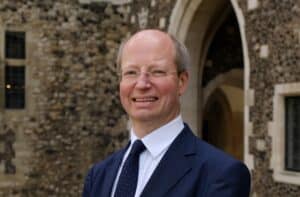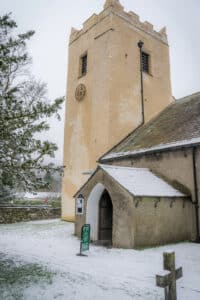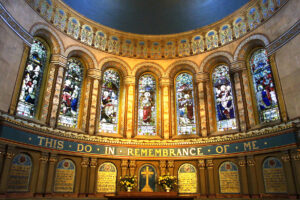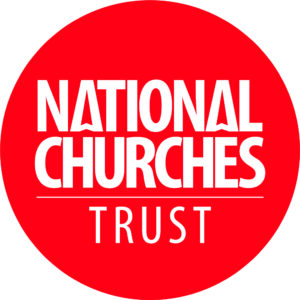 BBC News
BBC NewsBorrowing was £17.4bn last month, the second highest October figure since monthly records began in 1993.
Christopher Jackson
I have always been very fond of Philip Larkin’s poem ‘Church-Going’, where Larkin stops at a countryside church and takes off his cycle-clips ‘with awkward reverence’, walking around, until he decides ‘the place was not worth stopping for’. He ends up wondering ‘when churches shall fall completely out of use, what we shall turn them into.’ It’s a lovely poem for an England Larkin felt to be vanishing. The only line in the poem I think is definitely false is the line about it not being worth stopping for – not least because it gave him the poem itself.
I thought of the poem a lot after talking with Sir Philip Rutnam, until recently the permanent secretary at the Home Office, and now the Chairman of the National Churches Trust, a laudable organisation which seeks to help preserve the 39,000 or so places of worship in the United Kingdom.

So how did Rutnam acquire an interest in our churches and chapels? “My parents weren’t from a church-going family, though there was a lot of emphasis on education. It was a modest household in terms of income but it was a rewarding environment for me,” he tells me. “I was interested in history going as far back as I can remember. And buildings are one of the most tangible and engaging ways of seeing how the past continues to have an effect on us.”
Rutnam went on to study History at Trinity Hall, Cambridge: “I really loved it because it’s so varied,” he recalls. “You’re looking at everything from the origins of Europe after the fall of the Roman Empire through to neo-contemporary history of the United States with all sorts in between. It was a vast field – not just in terms of subjects but also in terms of ways of thinking about the past.”
So when did he become interested in churches? “When I became a teenager and had more freedom, I realised I could use that freedom to explore historical buildings. I would cycle off sometimes with friends, taking a copy of Pevsner, through southern England. I spent a long time exploring the churches of Kent, and Buckinghamshire.” It was the discovery of a love which continues to this day: “Just about everywhere one went, one could discover something unexpected, beautiful or extraordinary. It might be an amazing medieval chancel, or a Georgian monument or a Victorian sculpture. Scattered through the countryside and the towns of this country, are extraordinary buildings, and they’re too often underappreciated.”

St Oswald’s, Cumbria
“The state of our churches is the biggest problem facing our national heritage – by far.”
So why are they not better known? “The first thing is that these buildings get taken for granted; they become familiar. And familiarity can lead to lack of inquisitiveness or curiosity,” explains Rutnam. “Secondly, they’re often not well understood. If any one of the 15,000 Listed places of worship in England – and there are thousands more in Scotland, Wales and Northern Ireland – were in America it would be regarded as utterly extraordinary. The abundance of these buildings makes them their own worst enemy.”
So what can we do to redress that? Rutnam is clear. “We need to help people to recognise how exceptional it is that in this country there’s such an amazing collection of historic churches.”
Obviously, the challenge is doing this in an era of distraction – of memes and AI and and Taylor Swift and a million other things. But Rutnam is optimistic: “The decline in church-going has had an effect, yes, but actually very often you find that these buildings, even if the number in the congregation is less than it was 50 years ago, the building is still the centre of the community and regarded as such. It typically provides a wide range of activities beyond worship. Our challenge is to jolt people out of this sense of taking these places for granted.”
And how do you do that? “One thing is to make the buildings more accessible. That might not jolt but it will encourage. If we don’t, some people might hesitate metaphorically at the threshold and not go into the building because it’s unfamiliar and they haven’t been inside before. You need to make sure it’s got wheelchair access, as well as toilets and a kitchen. My church in North London has a nursery in it and holds Alcoholics Anonymous meetings.”
I think back on the role the church used to play, remembering how in Cartmel Priory in the Lake District, there is a loaf of bread behind one of the pillars, a memorial to the church’s traditional role in feeding the poor. Rutnam explains that this work continues today in ways we might not realise: “Many of our churches are hosts to food banks. There are more food banks hosted than there are branches of Macdonald’s in the country. There’s a modern version of the loaf of bread at Cartmel Priory at the food bank at Blessed Sacrament Church at Copenhagen street in North London, or Maryhill in Glasgow – and thousands of other examples.”
But we shouldn’t stop at simply making these magnificent buildings more accessible, Rutnam explains. “We also need to bring out the stories, and discover ways in which people can easily engage with the history behind the buildings. For instance, I went to the Parish Church in Ross-on-Wye a few weeks ago and they had a very cool bit of technology, which meant if you downloaded a QR code, and then raised your phone, you could see the medieval rood screen restored. The same thing could be applied in lots of different buildings. It’s to do with bringing up the variety of history there.”
Has the pandemic improved churches’ technology offering? Rutnam replies: “Covid-19 had a whole range of impacts. It’s now common for services to be online at the same time as they’re happening physically. But more generally technology’s quite a challenge for parishes, as these are by their very nature small organisations. We have 39,000 places of worship open for use, half of them listed buildings, and each one of those is effectively a small organisation – and, as with any small organisation – helping it to have the skills is a big challenge. One of the things organisations like ours could do is provide more of the common resources needed for technology to be adopted.”
When I think of my own experiences of visiting churches, I find that one reason that I might not stop is because it’s not always clear if the church itself will be open. One fears the rigmarole of parking up, trudging up to the steps and then finding the door locked. Sometimes it’s worth it – the door delightfully gives yielding the inside of the church, and the secrets within – but more often than not it doesn’t and you have to trudge back to the car. Larkin might have thought his church not worth stopping for, but he lived in an era when doors weren’t closed due the perception that otherwise they’d be ransacked by vandals.
Rutnam strongly agrees: “We would encourage churches to be open to the public regularly and indeed the standard advice from the main insurers for church buildings is to be open to the public regularly – it’s not to be closed, there are other risks to be associated with that. I understand it’s a challenge. Definitely at the minimum churches should advertise the hours they’re open and to be open not just on Sundays but for some point during the week. We run a website which is the largest source on this called Explore Churches.”
Of course, every church is unique, and each incumbent must choose a strategy. Not all churches can be like, say, St Bride’s off Fleet Street in London which has its famous relationship with the journalism profession. But Rutnam points out that every church has something to offer. “The main identity which churches have is a geographical one,” he says. “Everyone of us lives in a locality, whether we’re there for a month or for 30 years. Churches have an extraordinary role and potential.”
When it comes to the crucial business of maximising that potential, a lot currently seems to depend on the get-up-and-go of the individual incumbents. I can think of a range from the vigorous Dr. Alison Joyce at St Bride’s to the rather indifferent vicar at my local church in South-East London. Rutnam is sympathetic to the plight of clergy and eager to help: “Clergy are not generally trained as the operators and manager of buildings – understandably. It’s not a standard part of the theological training, but it has ended up being an important part of their job. One of our roles is to support not just clergy but also the small groups of volunteers, the church wardens, the church councils, and the people who end up involved in the running of the buildings, and to support them with easy to use advice and training about how to manage the difficult problems which come up.”
So how many volunteers are there exactly? “We’ve estimated there are about 400-500,000 volunteers. One of the things we try to do is make sure their role gets recognised. We have awards each year for volunteering. We provide some support and training on how to work with volunteers. You’ve got this incredible network of churches and chapels, and local organisations and what we seek to do is provide the best support we can for them.”

So there’s a lot of work to do, and I realise afterwards that I’d been talking to Rutnam for nearly an hour, and because of his soft-spoken, knowledgeable and gentle demeanour not really intuited the scale of the crisis. But now it begins to hit home: “We’re a relatively small organisation. We’re a national charity for this extraordinary group of buildings. We have about 5,000 members who support us each year. We also have regular donors, some of whom are individuals who have a strong alignment affinity for the cause, recognise the role churches play and some are from foundations and trusts such as The Pilgrim Trust which has been supporting this cause since we were set up in 1953.”
But here’s the rub: there’s far more support required than the NCT can currently provide. Rutnam sets it in context: “We’re able to distribute around £2-5 million a year on projects. That’s an appreciable sum but only part of the overall funding of projects which need to take place.”
So what sort of grants do they give? “We don’t give more than £50,000 to any one project, and in a typical project we fund about 200-300 a year. But each year we’re oversubscribed by a factor of three or four. There’s far more demand for funding to restore these buildings than there is funding available. As a result, the backlog of works is growing, and the threat to keeping these buildings open is also growing.”
To anyone who loves history – let alone anyone who loves churches – this is a dystopian vision of a country losing its connection to its past – exactly as Larkin feared.
“It’s very serious,” agrees Rutnam. “We need more donations. This is the single biggest issue by far facing our national heritage. Stately homes were an issue after the Second World War when the families who owned them didn’t have the money to keep them running; now the biggest problem is our churches and chapels. There are buildings which have closed recently because of major repairs which the congregation can’t fund but there are others which are in danger of foreclosure. The National Churches Trust has a role but so does Heritage Lottery Fund – and so, of course, does the government. These are fundamental public buildings which have been here for hundreds of years.”
So what is the UK government doing? The answer is shocking. ““Apart from being able to reclaim VAT on repair work, there is no regular funding from government. There was some funding during the pandemic as part of the Culture Recovery Fund and that was very quickly used to fund a whole range of major repairs of churches which urgently needed. That too, of course, was massively oversubscribed.
It’s a hard one to get up the agenda, he explains. “Scotland may provide us with a warning of what could happen in England, Wales and Northern Ireland. The Church of Scotland is going through a process of trying to reduce its church building estate by 40 per cent and a whole range of buildings, some medieval, have been identified for closure. Some are for sale at the moment on the Church of Scotland website.”
Of course, what happens to those sites will depend on the acquirer. Some will no doubt become housing, others will house retail store.
So how can the NCT connect with young people? “Sustainability is important and strikes a chord with many young people. As we deal with the huge existential challenge of climate change we have to make better use of our existing stock of buildings. We have to move away from a culture of demolishing buildings when we think they’ve finished one use and building something new – usually out of glass and steel. That’s not going to be sustainable in terms of their impact on the environment. Churches have overwhelmingly been here for hundreds and hundreds of years, and they have a huge amount of life left in them. It’s our duty to make the best of those structures, and adapt them for worship and for serving their communities. It’s eminently possible to do this in a way far more sustainable than the alternatives.”
Rutnam also makes another point: “The other thing for young people to be aware of is that there are opportunities – really rewarding opportunities – to work in the field of conservation. There’s a huge shortage of people with the skills needed to look after ancient buildings, working with your hands to carve stone, to repair wood, to the craft skills and there are some really good programmes available for apprenticeships at universities and degree programmes.”
It’s a remarkably clear case for action, made passionately by someone with a great deal of intelligence and quiet knowledge. Larkin ends that poem with a stanza that must be quoted in full:
A serious house on serious earth it is,
In whose blent air all our compulsions meet,
Are recognised, and robed as destinies.
And that much never can be obsolete,
Since someone will forever be surprising
A hunger in himself to be more serious,
And gravitating with it to this ground,
Which, he once heard, was proper to grow wise in,
If only that so many dead lie round.
It is that surprise of churches which we must preserve – and preserve it for as many generations as possible.

To find out more about and support the work of the National Churches Trust, visit nationalchurchestrust.org